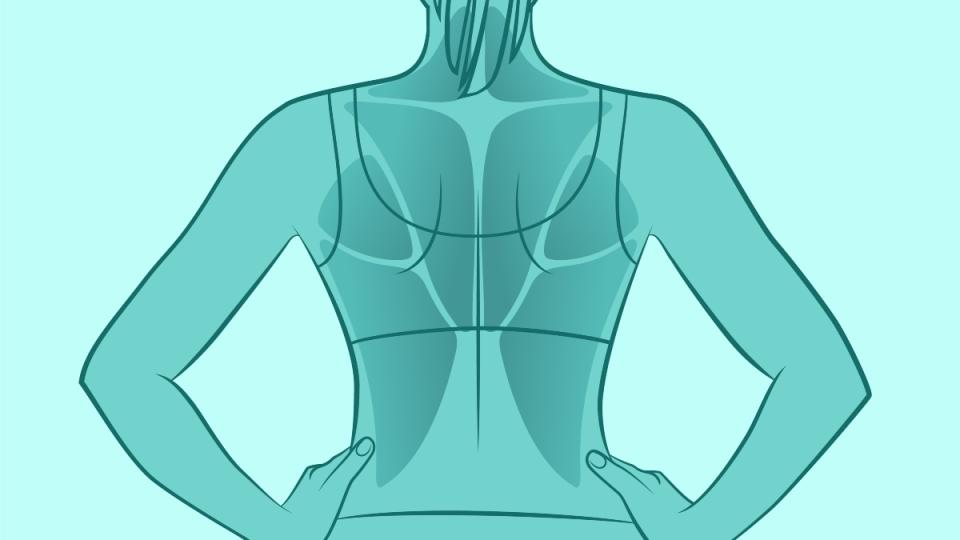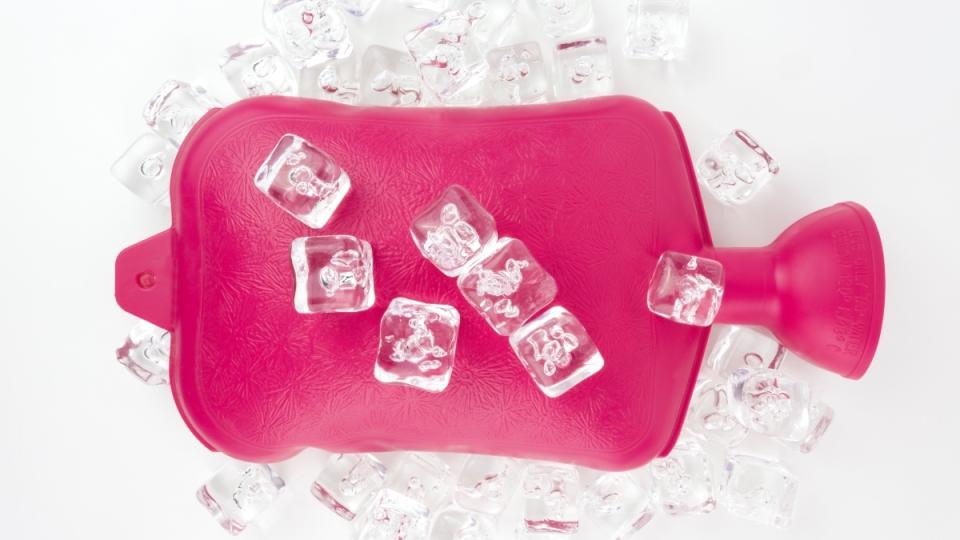Doctors Reveal the Easy Remedies That Deliver Powerful Relief From Mid Back Pain
We’ve all heard about — and likely experienced — lower back pain or discomfort around the neck and shoulders. But slightly less common, though possibly just as debilitating, is mid back pain. Here, we’re breaking down everything you need to know about pain that originates in the middle of the back, how it differs from upper and lower backaches, plus the easiest ways to banish mid back pain fast.
What causes mid back pain?
Like other types of back pain, there are a few different primary causes of soreness in the middle of the back. In most cases, this type of discomfort will feel similar to pain in the lower and upper back. Here are some of the most common causes.
1. Muscular issues
“One of the most common causes of middle back pain is myofascial pain (muscular pain),” explains Samantha Erosa, MD, an Interventional Spine and Pain Specialist at Och Spine at New York-Presbyterian and an Assistant Professor of Rehabilitation and Regenerative Medicine at Columbia University Medical Center. “Suboptimal posture in addition to frequent computer work can place excess stress on the mid back and create a pain between the shoulder blades.”
Muscular pain in the middle of the back will feel similar to muscular pain in other parts of the body, like a dull or throbbing soreness that is exacerbated by certain movements. (Click through to learn how a condition called pseduo sciatcia can trigger back pain, too, plus how to treat it naturally.)

2. A compression fracture
“In patients with severe pain and a history of osteoporosis, the cause of the middle back pain may be a compression fracture,” says Dr. Erosa. “This is a fracture of the vertebral body in the spine. The thoracic spine is located in the middle back and is the most common region for a compression fracture.”
Indeed, the thoracolumbar junction, the spot on the spine where it begins to curve inward that is located roughly where the ribs end in the middle back (if you were to draw a line from your front to your back), is the site of 60% to 75% of compression fractures. Discomfort from a compression fracture can start gradually and worsen over time, eventually becoming sharp, stab-like and potentially debilitating.

3. Arthritis in the spine
“Frequently, middle back pain is associated with degenerative disease of the spinal column, including the intervertebral disc and facet joints, as well as the surrounding muscles,” says Harvey Smith, MD, an Associate Professor of Orthopaedic Surgery at the Hospital of the University of Pennsylvania and the Veteran's Administration Medical Center. Also known as degenerative disc disease or arthritis in the spine, symptoms can range from minor soreness and stiffness to more severe pain.
4. Other medical conditions
“A multitude of medical conditions can present as back pain,” Dr. Smith says. “Accordingly, back pain that does not respond to initial management with physical therapy and/or anti-inflammatory medication necessitates a medical evaluation for alternative conditions.” For example, gastrointestinal issues, kidney problems, or other issues with the organs or structures in the abdomen can be felt as mid back pain. (Click through to learn how constipation can cause backaches — and how to relieve it naturally.)
Also, if your mid back pain is accompanied by other symptoms, you likely want to see a healthcare practitioner because there could be something else going on. “Back pain in the setting of fever (or other signs of infection), medical changes such as weight loss or changes in skin color, new-onset leg weakness, or bowel and bladder symptoms necessitate immediate evaluation,” notes Dr. Smith.

How mid back pain is diagnosed
“When approaching middle back pain, the initial assessment is key,” says Dr. Erosa. “Using physical examination, physicians are able to pinpoint which structure or structures is likely the biggest pain generator. Depending on the physical exam, an X-ray or MRI might be indicated for additional work-up.”
Indeed, if a doctor suspects a compression fracture, they'd use an X-ray or MRI to confirm and evaluate the extent before determining a course of action. One clue that the ache may be coming from your middle back: It's truly confined to your back. “Upper back and lower back pain can often radiate into the arms or legs, respectively, if due to a pinched nerve. However, in the middle back, pinched nerves are much less common,” Dr. Erosa says.
6 remedies for mid back pain
The cause of your mid back pain will determine the best course of action for treating it. Here are some of the strategies that healthcare practitioners would use, plus some study-proven remedies for easing discomfort fast.
1. Start your day with a parfait
To ease chronic discomfort and prevent it from coming back, savor a parfait made with Greek yogurt, granola and fruit. A study in Pain Reports that looked at over 4,000 people found that those who ate the most fruit, dairy and whole grains were up to 26% less likely to have chronic spinal pain. On the other hand, those who ate the most added sugars were 49% more likely to have chronic spinal discomfort. (Need recipe inspiration? Click through for recipes made with whole grain raw oats.)

2. Consider NSAIDs
“Mild flare-ups of back pain may be managed with over-the-counter nonsteroidal anti-inflammatory medications (NSAIDs),” Dr. Smith says. “They work well for degenerative middle back pain that is an episodic flare.” However, Dr. Smith adds that NSAIDs like ibuprofen and acetaminophen would not be recommended and likely wouldn’t provide much relief for a backache related to other medical conditions. In general, you should find relief from the dosages recommended on the bottle. If you don’t, talk to your healthcare professional to see if you may need a higher dosage.
3. Stretch it out
“A majority of middle back pain that is muscular can be improved with conservative treatments,” says Dr. Erosa. “Most patients benefit from physical therapy to improve biomechanics, positional awareness, and to develop a home exercise program.” Muscular soreness in the middle back is often a result of poor posture or spending long hours in uncomfortable positions. But a physical therapist can suggest easy stretches and exercises to help realign your posture.
“One great exercise is the 'scapular squeeze'," Dr. Erosa adds. "This is where the shoulders are brought back as if the shoulder blades are going to touch. It helps strengthen the mid back and can be done throughout the day in any spare moment.” To do: Stand or sit up straight and pull your shoulder blades down and together. Hold for a moment, then release. Do 10 reps. Need a visual guide to get started? Check out the video below.
4. Stand tall
Checking on your posture throughout the day and making tiny adjustments can go far toward reversing imbalances that are contributing to your pain, says Dr. Erosa. “Avoid rounded shoulders, keep your head in alignment with the rest of your spine, and bring your neck back so your head does not sit in front of your body,” she says. “These small adjustments reduce excess muscular stress in the mid and upper back.”
One trick Dr. Erosa suggests: Using a timer. “Especially if you’re working at the computer for long hours, setting a 20-minute timer to adjust your posture will help reinforce those adjustments,” she says. “With consistency, eventually the timer will no longer be needed.”
Related: How to Get Rid of a Neck Hump — And Soothe Neck and Back Pain in the Process
5. Opt for heat and ice
For mild discomfort, Dr. Smith recommends using both ice and heat, which work together to ease the ache. Ice restricts blood flow and reduces inflammation, while heat relaxes tense muscles. For both ice and heat, experts recommend using them for 15 to 20 minutes maximum at a time, followed by at least as much time off. Plan to alternate between the two? Wait two to three hours after using one treatment before using the other.
While many people like to alternate between ice and heat, you can simply stick with whatever works for you. If you prefer how you feel after just icing your back, for example, feel free to skip the heat. A study in Academic Emergency Medicine looked at patients with back strains. Researchers found 52% of folks who used heat for 30 minutes reported their pain as being better or much better, while 62% of those who used cold said the same. Likewise, 81% of people in the heat group and 76% of people in the cold group said they would use that modality again next time they were sore.

Tip: For longer lasting relief, consider a heated back patch. Johns Hopkins researchers found people who wore them for 8 hours daily cut even chronic backaches by 50% within three days. Heat boosts healing blood flow to sore tissues. Plus, it eases muscle spasms and activates thermoreceptors, temperature-sensitive structures on nerve endings that curb pain. One to try: ThermaCare Back Pain Therapy Heat Wraps (Buy from Amazon, $29.99).
6. Walk around the block
A leisurely stroll around the block may be more effective than muscle relaxants at relieving mid back pain, suggests research in BMJ. In fact, just moving about for 20 minutes reduces a backache by as much as 50%, suggests a study in The Spine Journal. Walking boosts your body’s production of the pain-relieving hormone serotonin. What's more, it works almost like massage from the inside out, realigning the spine and loosening muscles that cause discomfort.
Related: Doctors Share Natural Ways to Dodge Lower Back Pain When Walking
For more ways to ease back pain:
How to Get Rid of a Neck Hump — And Soothe Neck and Back Pain in the Process
Your Back Pain May Actually Be Caused by Uneven Hips — And These Exercises Can Help
This content is not a substitute for professional medical advice or diagnosis. Always consult your physician before pursuing any treatment plan.
First For Women aims to feature only the best products and services. We update when possible, but deals expire and prices can change. If you buy something via one of our links, we may earn a commission. Questions? Reach us at [email protected]
